With the short days and long nights its time to do some additions to the layout so I have ordered some more Metcalfe cardboard building kits which I will make up and add to the town centre. As I went to the local hobby shop rather than buy them off the internet there was also a chance to pick up 2 or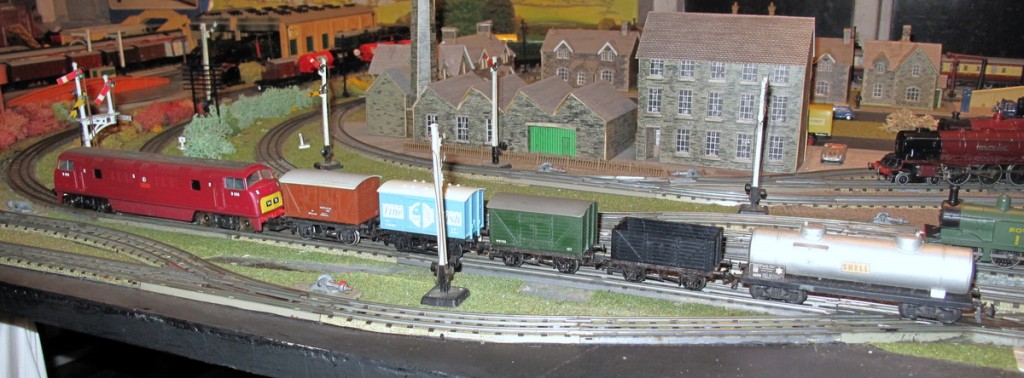 3 (or was it 4 or 5) second hand freight wagons with Triang type couplers to go behind the Warship which currently runs with a converter wagon. This has freed up some genuine HD trucks for elsewhere on the layout. At a £1 each they hardly broke the bank. These all plastic trucks are ideal behind the Warship which has lost its traction tyres and so will only pull a light load. In the photo we have a Lima Warship, 2 Hornby 12T Vans, a Triang 12T van, a Triang converter wagon and a Joeff bogie gas tanker which is HO scale but looks OK – not a HD item in sight but loads elsewhere on dublorunner.com
3 (or was it 4 or 5) second hand freight wagons with Triang type couplers to go behind the Warship which currently runs with a converter wagon. This has freed up some genuine HD trucks for elsewhere on the layout. At a £1 each they hardly broke the bank. These all plastic trucks are ideal behind the Warship which has lost its traction tyres and so will only pull a light load. In the photo we have a Lima Warship, 2 Hornby 12T Vans, a Triang 12T van, a Triang converter wagon and a Joeff bogie gas tanker which is HO scale but looks OK – not a HD item in sight but loads elsewhere on dublorunner.com
All posts by tony
Great Dublo Blog
I have just received a comment from Keith Pilkington and he asked if could link his blog to mine, which I was very happy to do.
So then I went to lo0k at his blog. WOW really good with some very rare Hornby Dublo enough to make me very jealous. However the layouts are really great and there is some very interesting stuff. Its a must visit for any Hornby Dublo Collector or Runner, certainly puts my effort into proper perspective.
Scroll down, passed a complete Terminus station, a Candian Pacific Loco, lots of interesting layouts until you get to Folkestone Harbour in 3 rail – really something.
Looks like the morning will be taken up reading the past posts.
The link is posted in the Links section but use this to go there immediately.
Neil Medhurst – dublobear
It was with shock and great sadness that I learnt today of the passing of Neil Medhurst well known on ebay as dublobear.
Neil has, through ebay, supplied over many years a good number of the 3 rail conversions that I run on my layout. During the last 2 or 3 years we have corresponded frequently and I have been able to have conversions specially made for me which have greatly enhanced my layout. My last three engines were all supplied by Neil. It seems amazing that my last loco, a Hornby Black 5 Conversion, might be the last that I will receive from Neil.
I will always remember Neil as I run his many trains around my layout, a person I never met but through the internet and ebay was first thought of as an honest and genuine trader and later as an ebay friend.
I will miss him and his conversions, my best to all his relations and friends.
Check on Links
I have checked all the links on the Links page.
Brian Schofield’s Hornby and Hornby Dublo Electric Trains have both seem to have left the web and have been removed from the links. The second one is depressing because this was the first site that I ever found on Hornby Dublo and through their Virtual Swap Shop I made some of my first purchases back in the days when you sent for a list of items for sale and relied on the buyer for an accurate description. Sorry to see that website go.
Paul Bartlett’s British Rail Wagons and the HRA have both changed their web addresses and these have been updated in the links.
I have also added a link to SCARM (Simple Computer Aided Railway Modeller) which is a software programme like Xtrac which enable you do build a theoretical layout of a 3 rail layout. You can also view it in 3D. I have to admit that it looks very clever, I have downloaded it but only used a little. I think that it is worth giving it a try and it has been very well received by the HRCA as they have had a lot of input to the programme so that it covers both Hornby Dublo 2 and 3 rail.
Autumn Approaches
The evenings are getting shorter, there is less work to do in the garden and therefore more time to play with the trains. Nothing really has been done to the layout throughout the Summer although trains have been run for a short time most days.
The carriage has had a new wheel set fitted and is now working well and the Schools Class has had a new traction tyre to its tender drive and is therefore back on active duties. I have also added a Lima Class 33, another Graham Farish 0-6-0PT and another Gaiety 0-6-0PT to the engine shed roster.
The last two models are totally in the HD time frame with heavy diescast bodies and simple mechanisms. The Gaiety engine is actually running on a modified HD 0-6-0T chassis and the extra weight compared to the original makes for very good running.
One of the things to decide for future layout work is whether I am going to add the extra electric points that I have to the new extension sidings replacing the current manual ones. This could be possible as these sidings are only for carriage or freight trucks and will not have engines stabled in them. The electric points are non isolating and to store engines it would require having isolating rails and switches.
Having made this decision I will then have to decide whether I will ballast this area – not sure at the moment. Still room for a few more buildings which is the winter jobby.
No pictures in this posting I will take some of the Black5 and the Class 33 for the next instalment.
Summer Slowness
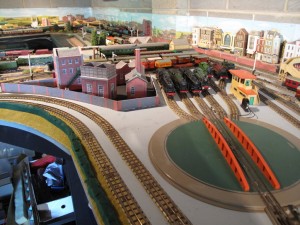 Very little work has been done on the layout although regular evening running is still in progress. I have not ballasted the new sidings or even the main line. The sidings have not been done as I still have a coupke of electric points that I am still in two minds whether to put or stay with the manual ones. Until I decide there is no point in doing any ballasting.
Very little work has been done on the layout although regular evening running is still in progress. I have not ballasted the new sidings or even the main line. The sidings have not been done as I still have a coupke of electric points that I am still in two minds whether to put or stay with the manual ones. Until I decide there is no point in doing any ballasting.
I have built a small industrial complex in this 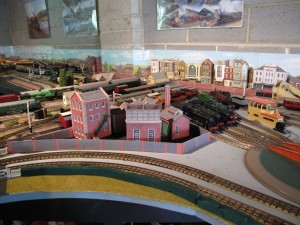 area although this was done a couple of months ago but I have only just got around to taking some pictures.
area although this was done a couple of months ago but I have only just got around to taking some pictures.
The running has been less than successful as my new Hornby Schools class has managed to throw one of its traction tyres off and therefore wont pull the skin of a rice pudding and one of the Southern suburban carriages managed to break its axle. Both of these problems need to be addressed before the 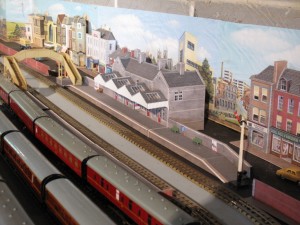 main season starts in the Autumn.
main season starts in the Autumn.
There has been one new purchase a Hornby Black Five converted to three rail running which is a good strong runner and yet another tender drive loco. Lets just hope that it doesn’t lose one of its traction tyre.
Building and Buying
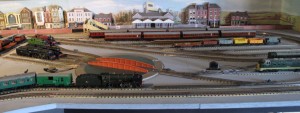 Although I continue to test the track especially the entry into the carriage and engine sidings I am hopeful that the two main lines are now OK and will not need changing. I have been building shops and a Cinema to add to the town behind the
Although I continue to test the track especially the entry into the carriage and engine sidings I am hopeful that the two main lines are now OK and will not need changing. I have been building shops and a Cinema to add to the town behind the 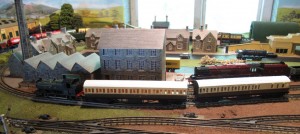 extension as well as a Mainline station. With the addition of a wall between the High Street and the railway this area is now nearly finished. The buildings are by Metcalfe and are very therapeutic and
extension as well as a Mainline station. With the addition of a wall between the High Street and the railway this area is now nearly finished. The buildings are by Metcalfe and are very therapeutic and
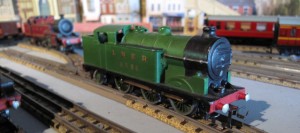
relatively easy to build. I think that they are much better than the alternative Superquick.
The acquisitions are
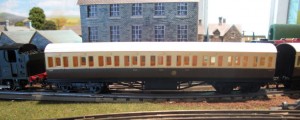
Two mint and boxed Graham Farish GWR suburban coaches to go behind the Graham Farish 0-6-0PT. These coaches are all plastic and well detailed but do not have the doors lined out and there no running numbers just the GWR circle. Nowhere near as nice as HD possibly on a par with Triang but they at least had running numbers. This train has been located on the small inner oval which will now act purely as a suburban branch line.
A HD 0-6-2T in LNER Green for the engine shed extension. and a HD BR(WR) coach plus another to come so that I can run WR trains on both lines.
Still testing
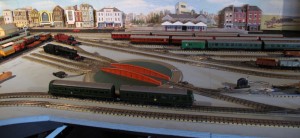 The main activity is still testing the extension track to make sure everything runs smoothly. Plus I have been standing contemplating the layout and have decided to move many of the trains from their current running track to new ones. Then you have to test if they run OK. The Wrenn
The main activity is still testing the extension track to make sure everything runs smoothly. Plus I have been standing contemplating the layout and have decided to move many of the trains from their current running track to new ones. Then you have to test if they run OK. The Wrenn 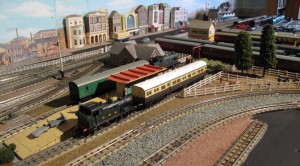 Merchant Navy with Pullman has moved to the down line and the Deltic with Maroon MK1 has moved to the up line and the small oval now has urban trains rather than express. Lots of other movements as well as some new acquisitions. I now have two Graham Farish WR coaches to match the Farish Tank engine – a nice little set up.
Merchant Navy with Pullman has moved to the down line and the Deltic with Maroon MK1 has moved to the up line and the small oval now has urban trains rather than express. Lots of other movements as well as some new acquisitions. I now have two Graham Farish WR coaches to match the Farish Tank engine – a nice little set up.
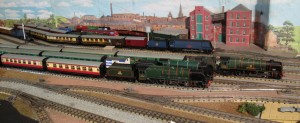 This is not playing with trains but serious testing.
This is not playing with trains but serious testing.
I have also been adding some buildings to the extension.
Lots to do.
Loving it.
Track and Running Advice from David Simmons
This is just excellent advice from David Simmons of use to all 3 rail runners. Fantastic information on points – really useful.
“I’m sorry to hear you are having all these problems. My experience of Dublo track (on and off for almost 60 years) is that it can be very troublesome, but can be beaten. It needs careful laying and only track that has passed rigourous inspection should be used.
A sheet of glass is useful to check that the rails are absolutely flat. Bases with obvious distortion should be either straightened if possible or scrapped. I avoid all track from the Korean war period (card insulators and steel rail are give aways). I also find that mixing wide and narrow tongues can sometimes give problems. The last section of curved rails is often straight, causing doglegs. Careful use of flat nose pliers corrects this – sighting along the rail shows up this one. Duchesses are near their limit on 15″ curves and don’t need any bad joints to worsen matters
Diamond crossings give trouble because the bakelite section in the middle warps (this also happens with uncoupling rails) and there is a bump between this and the metal part File smooth or scrap.
The real problem is, of course, the points, though I have not had particular problems with electric ones (it’s essential to check that the tiny spring underneath holds the point blades firmly over both ways however) . My investigations of these have revealed several problems. Firstly, the gauge through the blades widens to about 18mm. This is why fine scale wheels derail and only wide wheels like Dublo, Lima and later Tri-ang / Tri-ang-Hornby (This stuff is still Tri-ang to me despite usurping the Hornby name!) run through OK. Then, at the other end, the check rails are often bent out of shape and need restoring to their original form, so that the wheels are gently eased into line. Any burrs need removing obviously. Also check that the centre rail is level. Castles, 8Fs and 0-6-2 tanks in particular are prone to the collector shoes getting caught and derailing or shorting and stalling. Again flatness is essential.
I have found that some wheels are out of gauge (the back to back should be 14.2mm). This has to be corrected to avoid problems. A gauge or a vernier/digital caliper is necessary to check.
I’ve waffled on (as usual!) but a last point. To avoid uncoupling, all couplings have to be the same height (I have reserved one wagon with pristine couplings as my standard and all others have to couple and uncouple with this one). The hooks are ideally all the same (original) shape and it is essential that the actual coupling surface is vertical. Level track and attention to these points should mean unwanted uncoupling is rare.
I hope I’ve not stated too much that’s obvious, but I firmly believe in keeping them running rather than decaying away in some collector’s boxes.”
Thank you, David contributions welcome at any time.
Since this post David has sent me a follow up email with some further advice which is very useful and a picture of his now dismantled layout. Another runner, I hope that he gets a new layout soon.
“Hi Tony,
Thanks for your e-mail. Glad to be of assistance and the best of luck with your investigations. I’ve rescued some bad cases in the past., Corrosion and bad wear are the real killers.
The poorer examples can always be used in sidings or the loco depot where speeds are lower anyway. At worst, they can provide spare parts.
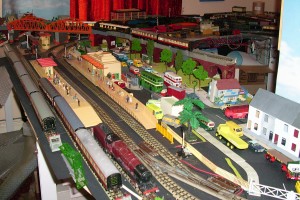
I would agree with you about 4MT tank bogies. they’re not quite heavy enough to take the coupling loads, especially with plastic wheels. I was going to try a phosphor bronze spring (like on the West Country), but have never got around to it. I didn’t have much success with the foam. The N2 (I have several of these) has never given bogie problems however. Possibly the axle is bent and the wheels don’t run true?
I’ve attached a photo of my old layout (now dismantled following a move, unfortunately) if you’re interested.
If you need any help don’t hesitate to ask.
Best regards,
David”
And then it all went pear shaped
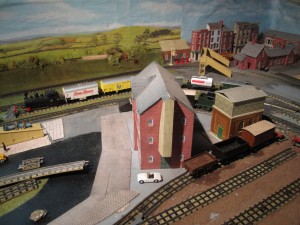 The new electric points arrived that I had bought from Peter Davies and the key one was fitted and wired up. Trains were sent around the track and then reversed into the sidings to check for derailments. Each engine and its train were being checked out and then out of the blue the engine just stopped. The auxilliary controller showed a dead short every time one tried to start the engine.
The new electric points arrived that I had bought from Peter Davies and the key one was fitted and wired up. Trains were sent around the track and then reversed into the sidings to check for derailments. Each engine and its train were being checked out and then out of the blue the engine just stopped. The auxilliary controller showed a dead short every time one tried to start the engine.
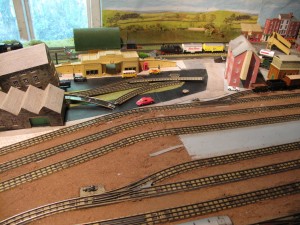 The multimeter had died over Christmas so the short had to be found by trial and error. The first thing to check was obviously the extension, suely it must be there. The new extension track was disconnected from the existing track. The extension connection from the main controller was removed. The auxilliary controller was wired directly to the extension now running seperate from the existing track. All was fine.
The multimeter had died over Christmas so the short had to be found by trial and error. The first thing to check was obviously the extension, suely it must be there. The new extension track was disconnected from the existing track. The extension connection from the main controller was removed. The auxilliary controller was wired directly to the extension now running seperate from the existing track. All was fine.
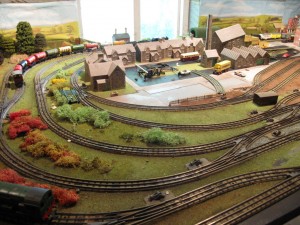 So track that had been laid between 2000 and 2004 and never given a problem all of a sudden had a dead short. Now this track is screwed down and ballasted and in some places almost impossible to get at. All the trains in that area had to be removed and stored. A mulitimeter was borrowed and testing began on each track section. Everything within easy reach was OK. Sods Law was fully operational. More trains were removed cushions were laid on the track so that I could kneel on them without damage to the track and the far flung eaches of the layout were checked. A short length of track the furthest away from the front was the problem. How, why who knows but there it was.
So track that had been laid between 2000 and 2004 and never given a problem all of a sudden had a dead short. Now this track is screwed down and ballasted and in some places almost impossible to get at. All the trains in that area had to be removed and stored. A mulitimeter was borrowed and testing began on each track section. Everything within easy reach was OK. Sods Law was fully operational. More trains were removed cushions were laid on the track so that I could kneel on them without damage to the track and the far flung eaches of the layout were checked. A short length of track the furthest away from the front was the problem. How, why who knows but there it was.
Unscrew the track replace the offending peice and all was fine but I took the opportunity to remove a point to a very small siding to reduce decoupling in this area and to slightly realign the track.
This took a lot of time as this slight realignment seemed to throw everything off and the re were derailments and decouplings. In the end I renewed all of the track in that area and started running all the trains again.
For the moment work on checking the electric point installation has stopped until this section is running reliably again
